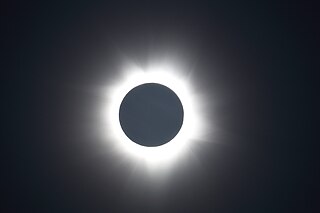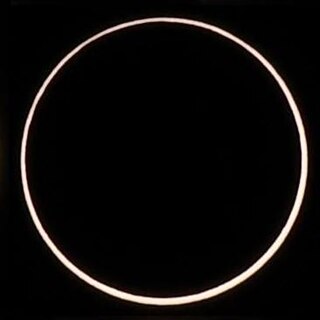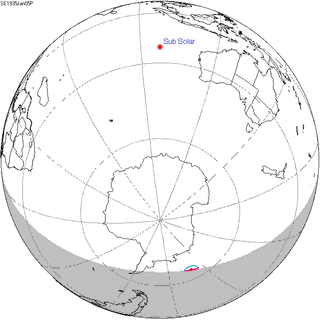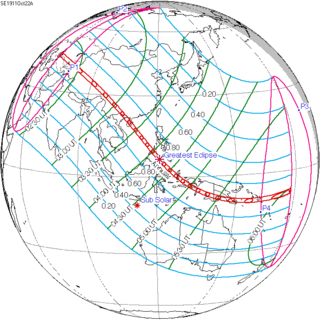
Apollo 11 was the spaceflight that first landed humans on the Moon. Commander Neil Armstrong and lunar module pilot Buzz Aldrin formed the American crew that landed the Apollo Lunar Module Eagle on July 20, 1969, at 20:17 UTC. Armstrong became the first person to step onto the lunar surface six hours and 39 minutes later on July 21 at 02:56 UTC; Aldrin joined him 19 minutes later. They spent about two and a quarter hours together outside the spacecraft, and they collected 47.5 pounds (21.5 kg) of lunar material to bring back to Earth. Command module pilot Michael Collins flew the command module Columbia alone in lunar orbit while they were on the Moon's surface. Armstrong and Aldrin spent 21 hours, 36 minutes on the lunar surface at a site they named Tranquility Base before lifting off to rejoin Columbia in lunar orbit.

Apollo 8 was the first crewed spacecraft to leave low Earth orbit and the first to reach the Moon, orbit it, and return. Its three-astronaut crew—Frank Borman, James Lovell, and William Anders—were the first humans to fly to the Moon, to witness and photograph an Earthrise, and to escape the gravity of a celestial body.

Apollo 16 was the tenth crewed mission in the United States Apollo space program, the fifth and second-to-last to land on the Moon, and the second to land in the lunar highlands. The second of Apollo's "J missions," it was crewed by Commander John Young, Lunar Module Pilot Charles Duke and Command Module Pilot Ken Mattingly. Launched from the Kennedy Space Center in Florida at 12:54 PM EST on April 16, 1972, the mission lasted 11 days, 1 hour, and 51 minutes, and concluded at 2:45 p.m. EST on April 27.

A day is approximately the period of time during which the Earth completes one rotation around its axis. A solar day is the length of time which elapses between the Sun reaching its highest point in the sky two consecutive times.

The full moon is the lunar phase when the Moon appears fully illuminated from Earth's perspective. This occurs when Earth is located between the Sun and the Moon. This means that the lunar hemisphere facing Earth – the near side – is completely sunlit and appears as a circular disk. The full moon occurs roughly once a month.
The minute is a unit of time usually equal to 1⁄60 of an hour, or 60 seconds. In the UTC time standard, a minute on rare occasions has 61 seconds, a consequence of leap seconds. Although not an SI unit, the minute is accepted for use with SI units. The SI symbol for minute or minutes is min. The prime symbol is also sometimes used informally to denote minutes of time.

In astronomy, the new moon is the first lunar phase, when the Moon and Sun have the same ecliptic longitude. At this phase, the lunar disk is not visible to the unaided eye, except when silhouetted during a solar eclipse. Daylight outshines the earthlight that dimly illuminates the new moon. The actual phase is usually a very thin crescent.

Tides are the rise and fall of sea levels caused by the combined effects of the gravitational forces exerted by the Moon and the Sun, and the rotation of the Earth.
The term dark moon describes the last visible crescent of a waning Moon. The duration of a dark moon varies between 1.5 and 3.5 days, depending on its ecliptic latitude. In current astronomical usage, the new moon occurs in the middle of this dark period,, when the Moon and Sun are in conjunction. This definition has entered popular usage, so that calendars will typically indicate the date of the "new moon" rather than the "dark moon".

Cannes is a city located on the French Riviera. It is a commune located in the Alpes-Maritimes department, and host city of the annual Cannes Film Festival, Midem, and Cannes Lions International Festival of Creativity. The city is known for its association with the rich and famous, its luxury hotels and restaurants, and for several conferences. On 3 November 2011 it hosted the 2011 G20 summit.
The 12-hour clock is a time convention in which the 24 hours of the day are divided into two periods: a.m. and p.m.. Each period consists of 12 hours numbered: 12, 1, 2, 3, 4, 5, 6, 7, 8, 9, 10 and 11. The 24 hour/day cycle starts at 12 midnight, runs through 12 noon, and continues just before midnight at the end of the day. The 12-hour clock has been developed from the middle of the second millennium BC to the 16th century AD.
The lunitidal interval measures the time lag from lunar culmination to the next high tide at a given location. It is also called the high water interval (HWI). Sometimes a term is not used for the time lag, but instead the terms age or establishment of the tide are used for the entry that is in tide tables.

Tide tables, sometimes called tide charts, are used for tidal prediction and show the daily times and levels of high and low tides, usually for a particular location. Tide heights at intermediate times can be approximated by using the rule of twelfths or more accurately calculated by using a published tidal curve for the location. Tide levels are typically given relative to a low-water vertical datum, e.g. the mean lower low water (MLLW) datum in the US.

A total lunar eclipse took place on March 3, 2007, the first of two eclipses in 2007. The moon entered the penumbral shadow at 20:18 UTC, and the umbral shadow at 21:30 UTC. The total phase lasted between 22:44 UTC and 23:58 UTC with a distinctive brick-red shade. The moon left the umbra shadow at 01:11 UTC and left the penumbra shadow at 02:24 UTC 2007-03-04. The second lunar eclipse of 2007 occurred on August 28.

A total lunar eclipse will take place on June 26, 2029. A dramatic total eclipse lasting 1 hour and 42 minutes will plunge the full Moon into deep darkness, as it passes right through the centre of the Earth's umbral shadow. While the visual effect of a total eclipse is variable, the Moon may be stained a deep orange or red colour at maximum eclipse. This will be a great spectacle for everyone who sees it from most of the Americas and western Europe and Africa. The partial eclipse will last for 3 hours and 40 minutes in total.

A total lunar eclipse will take place on January 31, 2037. The Moon will be plunged into darkness for 1 hour and 4 minutes, in a deep total eclipse which will see the Moon 21% of its diameter inside the Earth's umbral shadow. The visual effect of this depends on the state of the Earth's atmosphere, but the Moon may be stained a deep red colour for observers in north and west North America, most of Asia, Australia and New Zealand. The partial eclipse will last for 3 hours and 18 minutes in total. It occurs during a supermoon (perigee), and blue moon, just like the eclipse of January 31, 2018, one metonic cycle previous.

A total solar eclipse took place on 13–14 November 2012 (UTC). Because it crossed the International Date Line it began in local time on November 14 west of the date line over northern Australia, and ended in local time on November 13 east of the date line near the west coast of South America. Its greatest magnitude was 1.0500, occurring only 12 hours before perigee, with greatest eclipse totality lasting just over four minutes. A solar eclipse occurs when the Moon passes between Earth and the Sun, thereby totally or partly obscuring the image of the Sun for a viewer on Earth. A total solar eclipse occurs when the Moon's apparent diameter is larger than the Sun's, blocking all direct sunlight, turning day into darkness. Totality occurs in a narrow path across Earth's surface, with the partial solar eclipse visible over a surrounding region thousands of kilometres wide.

An annular solar eclipse occurred on September 1, 2016. A solar eclipse occurs when the Moon passes between Earth and the Sun, thereby totally or partly obscuring the image of the Sun for a viewer on Earth. An annular solar eclipse occurs when the Moon's apparent diameter is smaller than the Sun's, blocking most of the Sun's light and causing the Sun to look like an annulus (ring). An annular eclipse appears as a partial eclipse over a region of the Earth thousands of kilometres wide. In this case, annularity was observed in Gabon, Congo, Democratic Republic of the Congo, Tanzania, Mozambique, Madagascar, and Reunion.,

A partial solar eclipse occurred on January 5, 1935 during summer. A solar eclipse occurs when the Moon passes between Earth and the Sun, thereby totally or partly obscuring the image of the Sun for a viewer on Earth. A partial solar eclipse occurs in the polar regions of the Earth when the center of the Moon's shadow misses the Earth.

An annular solar eclipse occurred on October 22, 1911. A solar eclipse occurs when the Moon passes between Earth and the Sun, thereby totally or partly obscuring the image of the Sun for a viewer on Earth. An annular solar eclipse occurs when the Moon's apparent diameter is smaller than the Sun's, blocking most of the Sun's light and causing the Sun to look like an annulus (ring). An annular eclipse appears as a partial eclipse over a region of the Earth thousands of kilometres wide. Annularity was visible from the Russian Empire, China, French Indochina, Philippines, Dutch East Indies, Territory of Papua including the capital city Port Moresby, and British Western Pacific Territories.















